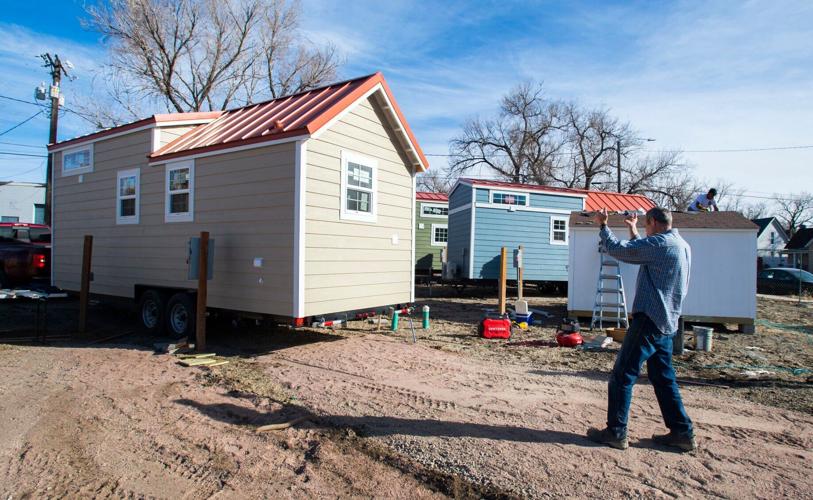Marked progress on a Colorado Springs woman’s vision to build a tiny home village for homeless young adults brought enough excitement to rival Santa’s chimney drop.
“I felt like a child at my first Christmas yesterday when those houses came,” said Shelley Jensen, a community strategist and founder of We Fortify, the nonprofit organization developing the project.
An inaugural five of 18 tiny homes planned for the new Working Fusion development in the Mill Street neighborhood in southwest downtown arrived Tuesday.
“Hopefully, this will change people’s lives,” said Rick Flaks, whose parents, the late Stanley and Regina Flaks, bought several homes in the working-class Mill Street area in the 1970s and for decades rented them to low-income families.
Brothers Rick and Greg Flaks were going to raze the homes — which had become dilapidated and illegally occupied by squatters — and build a storage-rental business.
Instead, they decided to follow their parents’ charitable example and give Jensen a deal in leasing the land for the first transitional housing model of its kind in the city.
“My parents were always advocating for the underdog,” Rick Flaks said. “They’d both be proud of this. It’s a good way to honor their memory.”
Jensen thought of the idea nearly five years ago, researched and studied it, amassed supporters and launched the project as the COVID-19 pandemic was beginning.
She had hoped to have residents in place by October 2020, but fundraising stalled as construction materials became scarce, and the price of a tiny home escalated from $49,000 in 2019 to $65,000 two years later.
Now the derailed project is back on track.
This month, the first residents will move in to the fully furnished, 240-square-foot new homes off South Sierra Madre Street and Fountain Boulevard.
Six old houses occupying .63 acres, roughly two-thirds of a city block, were torn down to make way for the tiny homes.
Residents are 18 to 25 years old and have been referred to the program by a social service agency. Some have aged out of the foster care system and don’t have anywhere to live; others have been couch-surfing or living with families or friends and need a better plan.
After going through a lengthy interview process, accepted residents must sign a two-year lease agreement and contract to be a “good neighbor” and agree to such conditions as not playing music too loudly, not allowing trash to accumulate and not smoking in the immediate area.
“The goal is to have them be a good neighbor, so when they move out, they know how to do that,” Jensen said.
Likewise, each unit has a stacked washer and dryer, so residents learn what it’s like to do laundry in their home, she said.
Renters must have jobs and will be charged $600 a month plus utilities. That’s 40% of the area median income, so the houses meet the definition of “affordable.”
The goal: “to create an environment for them to budget and plan for their future,” Jensen said.
The organization is operating on several “pillars” that revolve around providing “dignified housing,” she said.
The model is the opposite of traditional assistance programs, which use rewards to incentivize participants. In this case, residents are being provided everything from pots and pans to a full-size bed and a small couch — all of which they get to take with them when they move on to permanent housing.
“It says, 'We’re trusting you to be a good steward of these possessions,” Jensen said. “So, if John says, ‘I got angry and broke all my dishes,’ we say, ‘I guess you’ll be eating off paper plates for a while, until you can budget to buy more dishes.’”
Of the $2.2 million project cost, about $1.5 million has been raised, according to Jensen.
Two additional houses, built locally by Tiny Building Experts, will be moved into the development each month, with Jensen seeking funding for the final six units.
Simultaneously, Jensen wants to construct a building to the north, to hold classes for residents on independent living, cooking, budgeting and other skills; provide space for yoga lessons, community events and activities; display public art; and create social enterprise to help support We Fortify.
The mixed-use building also will house the organization’s offices on the second floor, along with three affordable apartments, Jensen said. She also wants to build 19 market-rate apartments.
The cost hasn’t yet been determined, she said, as the project is in the planning and approval stages.
Volunteer Barney Mulcahy is building a rammed-earth fence surrounding the property, which backs what’s often called the “homeless highway” — the path homeless people walk between the Marian House soup kitchen and the Springs Rescue Mission shelter.
Mulcahy said he was homeless as a child in Korea, where he grew up on the streets.
“I’ve been there, done that, lived it,” he said. “I have a real understanding of the human nature of suffering and being homeless.
“I’m so glad and proud of this project. I like to step up and give Shelley a hand as much as I can.”











(0) comments
Welcome to the discussion.
Log In
Keep it Clean. Please avoid obscene, vulgar, lewd, racist or sexually-oriented language.
PLEASE TURN OFF YOUR CAPS LOCK.
Don't Threaten. Threats of harming another person will not be tolerated.
Be Truthful. Don't knowingly lie about anyone or anything.
Be Nice. No racism, sexism or any sort of -ism that is degrading to another person.
Be Proactive. Use the 'Report' link on each comment to let us know of abusive posts.
Share with Us. We'd love to hear eyewitness accounts, the history behind an article.